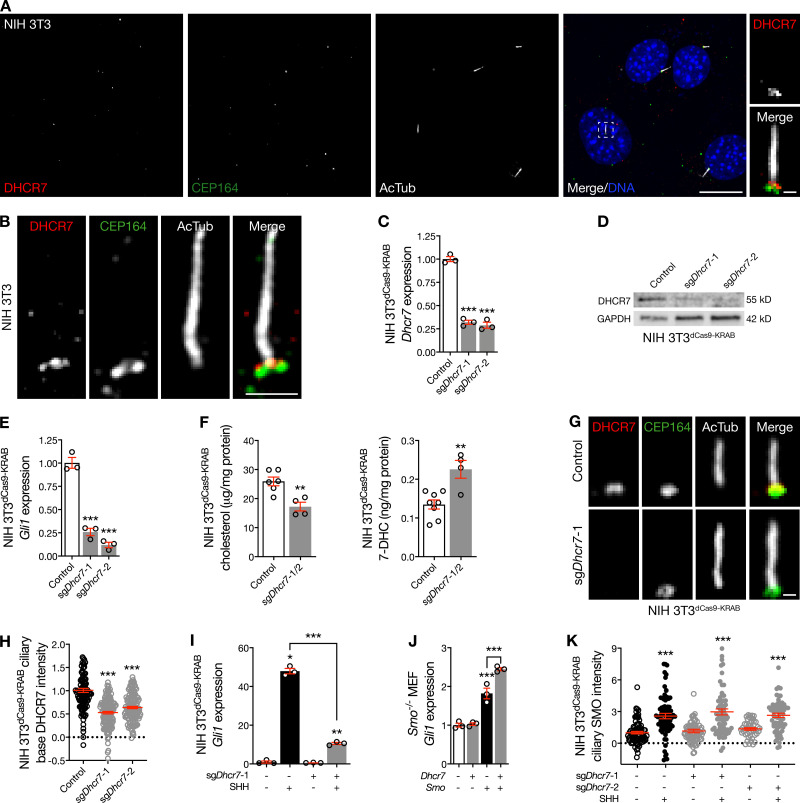Figure 1.
DHCR7 localizes near the ciliary base and activates the Hedgehog pathway. (A) Immunofluorescence confocal microscopy for DHCR7, the ciliary protein acetylated tubulin (AcTub), and the centriole protein CEP164 demonstrates that DHCR7 localizes near the ciliary base in NIH 3T3 cells. DNA is marked with Hoechst 33342. Main scale bar, 10 µm. Inset scale bar, 1 µm. (B) Superresolution microscopy validates DHCR7 localization near the ciliary base, at the level of CEP164, in NIH 3T3 cells. Scale bar, 1 µm. (C) qRT-PCR assessment of Dhcr7 expression in NIH 3T3 cells expressing the CRISPRi components dCas9-KRAB (NIH 3T3dCas9-KRAB) after transduction of sgRNAs targeting Dhcr7 (sgDhcr7) demonstrates Dhcr7 suppression compared with transduction control (ANOVA). (D) Immunoblot assessment of NIH 3T3dCas9-KRAB lysates after transduction with sgDhcr7 validates DHCR7 suppression compared with transduction control. (E) qRT-PCR assessment of Gli1 expression in NIH 3T3dCas9-KRAB cells after transduction of sgDhcr7 compared with control demonstrates that Dhcr7 suppression inhibits the Hedgehog transcriptional program (ANOVA). (F) Mass spectrometry–based sterolomics demonstrate reduced expression of cholesterol and increased expression of the 7-DHC in NIH 3T3dCas9-KRAB cells transduced with sgDhcr7 compared with control (Student’s t test). (G and H) Quantitative immunofluorescence confocal microscopy for DHCR7 after transduction of sgDhcr7 in NIH 3T3dCas9-KRAB cells confirms that DHCR7 localizes near the ciliary base and Dhcr7 suppression reduces DHCR7 intensity near the ciliary base (ANOVA). Scale bar, 1 µm. (I) qRT-PCR assessment of Gli1 expression in NIH 3T3dCas9-KRAB cells transduced with sgDhcr7 reveals Dhcr7 that suppression attenuates the Hedgehog transcriptional program in response to SHH (ANOVA). (J) qRT-PCR assessment of Gli1 expression in Smo−/− MEFs transfected with Dhcr7, Smo, or both demonstrates that Smo is required for Dhcr7 to activate the Hedgehog transcriptional program (ANOVA). (K) Quantitative immunofluorescence confocal microscopy for Smoothened in NIH 3T3dCas9-KRAB cells after sgDhcr7 transduction demonstrates that Dhcr7 suppression fails to block Smoothened accumulation in cilia in response to SHH compared with either control cells treated with vehicle or cells expressing sgDhcr7 treated with vehicle (ANOVA). *, P ≤ 0.05; **, P ≤ 0.01; and ***, P ≤ 0.001. Error bars represent SEM. The sample size of each experiment is represented by the number of independent data points on each graph. Each experiment is representative of at least three independent biological replicates.

